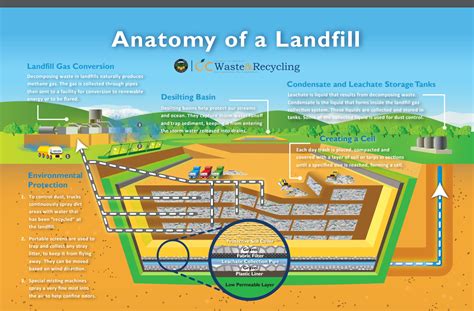Introduction
A sanitary landfill is an engineered facility designed to safely dispose of solid waste while minimizing environmental impacts. It is an essential component of modern waste management systems, handling waste that cannot be recycled, composted, or otherwise diverted from landfills. This diagram provides a comprehensive overview of the key components and processes involved in the operation of a sanitary landfill.

Landfill Components
The diagram below illustrates the main components of a sanitary landfill:
[Diagram: Sanitary Landfill Components]
- Waste Cells: These are large, excavated areas where waste is placed and compacted.
- Leachate Collection System: Pipes and pumps collect leachate, liquid that seeps from waste, and direct it to treatment facilities.
- Gas Collection System: Wells and pipes capture landfill gas, which is primarily composed of methane and carbon dioxide, for use as energy or for flaring.
- Cover Material: Soil or other materials are used to cover waste cells, preventing access by pests and controlling odors.
- Monitoring Wells: Ground and surface water are monitored to ensure that landfill operations are not contaminating the surrounding environment.
Landfill Operations
The operation of a sanitary landfill involves the following steps:
1. Waste Acceptance and Preparation
- Waste is delivered to the landfill in trucks or containers.
- Unacceptable waste, such as hazardous materials, is rejected.
- Acceptable waste is weighed and inspected.
2. Waste Placement
- Waste is placed in a designated waste cell.
- Heavy equipment compacts the waste to increase density and reduce airspace.
- Waste is covered with soil or other cover material at the end of each day.
3. Leachate Management
- Leachate is collected and pumped to a treatment facility.
- Treatment processes typically include chemical addition, settling, and biological treatment.
4. Landfill Gas Management
- Landfill gas is collected and removed from the landfill.
- Gas can be used as a fuel source for electricity generation or flared to prevent its release into the atmosphere.
5. Monitoring and Maintenance
- Groundwater, surface water, and air quality are monitored regularly to ensure compliance with environmental regulations.
- Landfill equipment and infrastructure are inspected and maintained as needed.
Benefits of Sanitary Landfills
Sanitary landfills offer several benefits, including:
- Safe and Controlled Disposal of Waste: Landfills provide a controlled environment for the disposal of waste, minimizing risks to public health and the environment.
- Generation of Renewable Energy: Landfill gas can be harnessed as a renewable energy source, reducing reliance on fossil fuels.
- Recovery of Valuable Materials: Some landfills incorporate recycling and composting programs to recover valuable materials from waste.
- Land Reclamation: After a landfill is closed, the site can be reclaimed for other uses, such as parks or green spaces.
Environmental Concerns
Sanitary landfills have the potential to create environmental concerns, including:
- Land Use: Landfills require a significant amount of space and can impact land values.
- Water Contamination: Leachate can contaminate groundwater if not properly managed.
- Air Pollution: Landfill gas can contain harmful pollutants that can contribute to air pollution.
- Climate Change: Landfill gas is a potent greenhouse gas, contributing to climate change.
Key Statistics
- The United States generates over 260 million tons of municipal solid waste annually.
- Approximately 55% of U.S. waste is disposed of in sanitary landfills.
- The average lifespan of a landfill is 20-30 years.
- Landfill gas can produce enough electricity to power over 1 million homes annually.
Emerging Concepts
- Bioreactor Landfills: Landfills that enhance waste decomposition through aeration and moisture control, accelerating gas production and leachate reduction.
- Circular Economy Landfills: Landfills that focus on resource recovery, such as extracting recyclable materials and generating renewable energy.
- Smart Landfills: Landfills that incorporate technology for real-time monitoring, data analysis, and automated operations to optimize performance.
Tips and Tricks for Optimizing Landfill Operations
- Implement effective waste sorting and recycling programs to divert waste from landfills.
- Compact waste thoroughly to increase density and minimize airspace.
- Cover waste cells regularly with soil or other cover material to control odors and prevent access by pests.
- Monitor groundwater, surface water, and air quality regularly to ensure compliance with environmental standards.
- Explore innovative technologies, such as bioreactors and smart landfills, to improve landfill performance and sustainability.
Common Mistakes to Avoid
- Allowing unacceptable waste into the landfill.
- Improper waste compaction and cover placement.
- Inadequate leachate and landfill gas management.
- Neglecting environmental monitoring and maintenance.
- Failure to incorporate best practices and emerging technologies.
Step-by-Step Approach to Landfill Management
- Plan and Permit: Obtain necessary permits and design the landfill according to engineering and environmental standards.
- Construct: Excavate waste cells, install leachate and gas collection systems, and establish monitoring systems.
- Operate: Accept waste, compact it, cover it, and manage leachate and gas.
- Monitor and Maintain: Regularly assess landfill performance and make necessary adjustments.
- Close and Reclaim: When the landfill reaches capacity, close it according to regulations and reclaim the site for future use.
